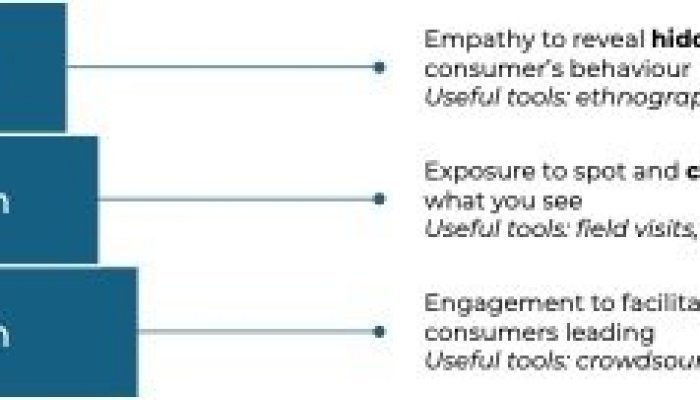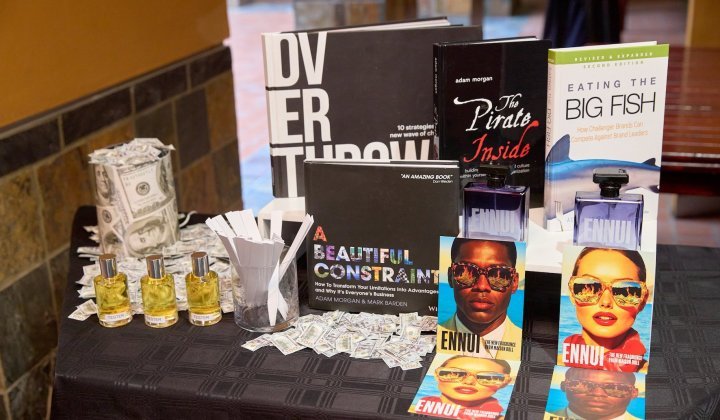In the past, we connected with people. Today we have a flood of data to draw on that can tell us everything we think we need to know about customer sentiment, brand health and marketing effectiveness. In this data-driven world, you no longer needed to speak to customers. Everything is at your fingertips. Right there, from the comfort of your desk.
Such is the value attributed to customer data and social media responses that brands across all sectors have worked themselves into a frenzy about quantitative data, believing it holds the key to getting differentiated marketing strategies right and creating targeted campaigns.
However, as we’ve become a little more comfortable with data — and a little less blinkered about its pitfalls and potential — it has become clear that access to all this information hasn’t really sparked a wealth of breakthrough ideas. In fact, from a strategic perspective, many brands are struggling to find the “what next?” nugget buried in all of it.
Let’s circle back to people
As a specialist strategic consultancy that is always searching for ways to give our clients the edge, we regularly engage in introspection and deliberation about the best methods to unearth valuable customer insights. We concluded that while data is useful as a diagnostic check, it doesn’t give the full picture. What is typically missing is the costlier, more time-consuming, qualitative insights that flesh out the hard facts; the layers of understanding that help us answer those pressing “what next?” questions for our clients.
We merged our on-the-ground experience with methodologies from PwC experts like Ian Kahn, Paul Leinwand, and Mahadeva Matt Mani, as well as Marcus Collins, the respected US marketer who argued that “today’s marketers have mistaken information for intimacy”.
Kahn, Leinwand, and Mani, meanwhile, wrote that “privileged insights” were necessary to unlock intimacy and trust. “Unlike market research, privileged insights provide intel on your customers’ real needs, desires, and experiences. Generally, it requires engaging with customers in ways that directly build trust and value. This might include offering services and solutions that go beyond products, creating a more robust and engaging customer service experience, integrating customers into product and service development, and observing and interacting with customers while they use your products.”
As we began to crystallise our own ideas, a three-tiered concept emerged: rooted customer insight.
What is rooted customer insight?
While we recognised the importance of helping companies look beyond surface-level data insights, we also realised that not every company required the same level of qualitative intervention.
Some clients wanted to draw their customers closer to the brand to foster a greater sense of connection and ownership; they wanted to listen and engage. We termed this approach interaction to co-create.
Other organisations needed to dig a little deeper to appreciate how customers might be using their products or services, and what the sticking points might be for them. Here, immersion to connect the dots was a useful tool.
Finally, we saw brands that really needed to tap into the psyche of their customers at a more intimate level to appreciate why they were consuming in a certain way or favouring a competitor’s offering. This intervention we termed intimacy to reveal hidden truths.
Rooted customer insight
Practically, the level of understanding a company is seeking should ultimately guide their objective and the degree to which our team must dig to unearth richer insights. If the objective is innovation, then the interaction level is a suitable fit since it helps with co-creation. For brands that are losing their edge and looking to find fresh meaning in the market, an immersion approach is best.
Once the intention is clear, and the type of approach has been determined, it is time to put the desired plan of action into operation.
This is where it gets interesting and where the double-barrel power of creativity and innovation of a good consultancy comes into its own. Rather than seeking to please everyone and measure every single data point using a catch-all approach, this focused method allows teams like ours to pitch the type of qualitative engagement at just the right level to unlock the desired connection.
Here are just a few examples to take you behind the scenes.
Interaction: Diageo in East and West Africa
Premium drinks maker Diageo was looking to bring something fresh to the East and West Africa market, but any innovation had to connect with customers. Our starting point was the data. We looked at the opportunity spaces it had mapped and built some hypotheses from those. We then conducted a series of sprint workshops in Lagos, Nigeria to delve into the potential innovations that we felt had merit.
We ran our internal sprint workshops during the day and then, in the evening, brought consumers in to test the day’s ideas and to gauge what they liked and what they’d add or change. The next day we’d work through that feedback and test again. This interactive approach really helped us to shape and refine the concepts. It was pretty surprising, and humbling, when one of our favourite suggestions absolutely bombed, but another, less favoured idea was enthusiastically received.
Ultimately, by co-creating these concepts with customers, we arrived at a shortlist of innovations which we could confidently put to the client for consideration. We concluded this process at the end of 2023 and Diageo is currently undertaking capability and feasibility testing, which could take a further 12-18 months. So, it’s a matter of watching this space for more.
What we do take heart from has been the response from Diageo. Jonny Maunder, Diageo’s Africa innovation marketing manager, told me: “Working with this team helped us challenge ourselves! They brought fresh insights from outside the alcohol category, pushing our thinking in new directions. They made sure the consumer was front and centre, keeping us from marking our own homework. Best of all, they helped us challenge category conventions and see constraints as springboards that propel us forward.”
Immersion: Windhoek in South Africa
Closer to home, we worked with Windhoek in South Africa. This was a clear-cut case of using immersion to get to the heart of consumer motivation and preference.
Using field visits and interviews, we focused on people already drinking Windhoek. We discovered that society and masculinity had progressed from the brand’s marketing approach at that time, which was pushing the “real men drink beer” narrative. Our qualitative research showed us that Windhoek drinkers really didn’t care. They chose to drink Windhoek because they wanted to, and the brand needed to capture this evolution.
In fact, in our interactions some people even told us they liked being the only one drinking a Windhoek. It made them stand out. Working with the agency partner, we landed on the pay-off line “100% Real”, which reinforced the attitude of Windhoek drinkers and connected directly to the functional attribute of 100% pure beer. This shift gave new energy to the brand, which was reinforced by a well-timed packaging change by the brand.
The new-look, contemporary Windhoek launched in late 2023.
Intimacy: Yoco in South Africa
A great example of a strategic intervention focused at the intimacy level is Yoco. We started working with this exciting, homegrown brand in 2019 when the company was seeking to unearth hidden truths in the South African fintech space. The business was six years old at that point, and looking to accelerate growth. The team had already undertaken some segmentation work in the small- and medium-sized (SME) business market, and created personas around needs and barriers, but they were unclear how to move forward. Initially, we worked with Yoco on positioning the brand, and later around marketing planning and optimisation.
We wanted to create a clearer and more compelling reason for SMEs to buy into Yoco’s ecosystem of card payment machines, but first we needed to connect with the customer base on a deeper level. We held a series of workshops and, based on these insights, soon began to appreciate that while these business owners might be classified as SMEs, they certainly didn’t see themselves as small. They had big plans, but felt institutional red tape was holding them back from entering the major leagues.
These insights crystallised our approach, which positioned Yoco as a catalyst for growth. Yoco’s “We the Underdog” campaign (developed by creative agency Halo) was born out of these client engagements, which highlighted the resilience, determination, and guts of SME business owners. In 2019, when Yoco introduced additional devices, these insights enabled us to match the best device for each segment.
Prior to the repositioning in 2019, Yoco had 36 000 merchants. By the end of 2023, the number had ballooned to 350 000. Reflecting on the power of unlocking – and acting on – the right hidden truths in your customer base, Yoco’s former head of marketing Matt Bronwell says: “The work we did with Eatbigfish was a catalytic moment for Yoco. We went from a small, slightly unsure start-up to a brand with a confident voice and big ideas to bring that voice to life. And so started a 10x growth journey that is still going.”
What’s stopping you and your brand?
From Yoco to Windhoek, it’s clear that without an appropriate qualitative lens, even the most well-conceived marketing intentions will fall flat if the voice and input of customers are treated only as data points and not rich, rooted customer insight.
Our work with rooted customer insights has shown that qualitative, human-centric knowledge helps with effectiveness by identifying issues in the brand or category that are holding it back from being the best it could be. Data can tell you if people are abandoning their check-out carts, but it can’t tell you why. However, when you engage with a customer and they tell you their frustrations about payment processes taking too long, or being too complicated or too limited, then you can begin to identify innovative ways to fix that specific pain point.
Starting on this journey is oddly simple: you get out from behind the desk and focus on the quirky, unexpected, messy human experience. The data won’t tell you, but there are gems in that chaos and complexity.
Key takeaways
- Data has created a level playing field. We all have access to the same quantitative data — but this reveals no differentiation.
- Strategic businesses build on data by adding qualitative rooted customer insight for additional depth.
- Qualitative customer insights can lead to better optimisation and more effective marketing, while also exposing sticking points and customer challenges.
Tumisang Matubatuba is strategy director at Eatbigfish Africa, a strategic consultancy focused on challenger brand strategy. A GIBS graduate who holds a Master’s Degree in Corporate Strategy, Matubatuba has extensive strategic experience that spans industries and geographies. With a keen interest in human behaviour and consumer trends, he is driven to craft brands that make a meaningful impact in the lives of Africans. Matubatuba previously worked at Unilever as the brand development custodian of the Omo and Sunlight brands in East and West Africa. As a strategist, his client projects include leading names such as Sanlam, Santam, Heineken Beverages, Diageo, Showmax, Vodacom, Thungela Resources, Discovery, Nedbank, and Standard Bank.







